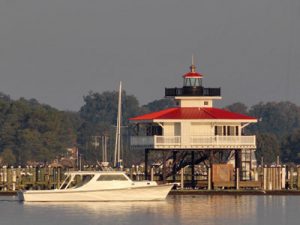
Located on Maryland’s Eastern Shore, the Choptank River is the longest river on the Delmarva Peninsula. Along its path are several historic communities including Goldsboro, Denton, Secretary, Cambridge, and others.
The river provides critical habitat for striped bass, river herring, oysters, blue crabs, and other marine life.
The lower Choptank River is famous for its oyster beds. Parts of the lower Choptank are opened seasonally for commercial oyster harvesting. Numerous oyster sanctuaries are located in the Choptank River, Latrappe Creek, Little Choptank, and other areas.
During the summer season, watermen shift from oystering to crabbing. Along much of the river, trotlines are the most common type of crabbing gear.
Near Cambridge, the Bill Burton State Park fishing pier attracts visitors year round. Pier anglers catch striped bass, white perch, catfish, spot, and other species. The pier is also known as a productive location for crabbing, especially during mid-summer through fall. In winter, the pier attracts birdwatchers that come to see diving ducks, geese, and other aquatic birds that congregate in the river below.
The Choptank is one of four major fish spawning systems monitored by the Maryland Department of Natural Resources (DNR). The annual DNR juvenile striped bass survey documents year-class success for young-of-the-year striped bass (Morone saxatilis) and relative abundance of many other fish species in Chesapeake Bay.
Just below the mouth of the Choptank is James Island. Once nearly gone, the island restoration is part of the U.S.Army Corps of Engineers Mid-Chesapeake Bay Island Ecosystem Restoration project. Also known as Mid-Bay Island, the project is focused on restoring and expanding island habitat to provide wetland and terrestrial habitat for fish, shellfish, reptiles, amphibians, birds, and mammals through the beneficial use of dredged material.
Related Information